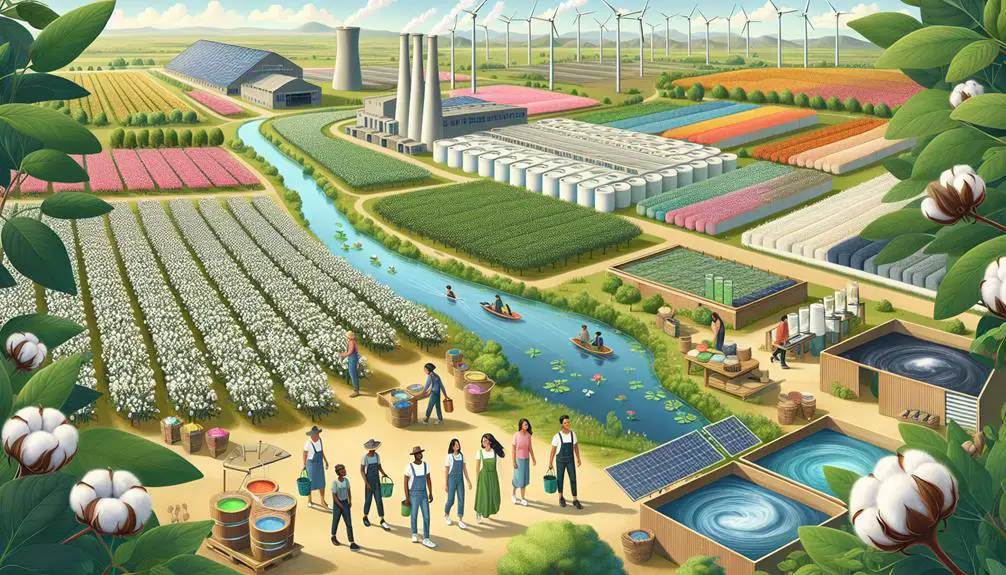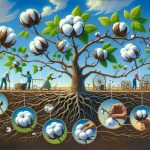It's interesting that you're thinking about sustainable fabric production just as the industry is starting to embrace these practices more widely. By considering organic farming techniques, you can see how crop rotation and natural fertilizers benefit the environment. Eco-friendly dyeing processes, recycling, and upcycling old textiles are equally vital. Zero-waste manufacturing and energy-efficient production technologies also play significant roles in this shift. But how do these methods come together to create a truly sustainable textile industry? You'll find that the answers are both innovative and practical.
Table of Contents
Key Takeaways
- Incorporate crop rotation to maintain soil health and reduce pests.
- Use natural fertilizers like compost to enrich soil without synthetic chemicals.
- Implement low-water or waterless dyeing technologies to conserve water.
- Recycle and upcycle old textiles to minimize waste and support a circular economy.
- Invest in energy-efficient machinery and renewable energy sources like solar power.
Organic Farming Techniques
Organic farming techniques prioritize natural processes and materials to cultivate sustainable fabrics. To achieve this, you should start by incorporating crop rotation into your farming methods. Crop rotation not only improves soil health but also reduces the risk of pest infestations and diseases. By alternating the types of crops grown in a particular area, you help maintain the balance of nutrients in the soil, allowing for healthier and more resilient plants.
Using natural fertilizers is another essential practice. You can opt for compost, manure, or green manure to enrich the soil without resorting to synthetic chemicals. These natural fertilizers provide essential nutrients and improve the soil structure, which in turn enhances the quality of the fabric produced from these crops.
Eco-Friendly Dyeing Processes
When you're aiming for sustainability in fabric production, adopting eco-friendly dyeing processes is an essential step. You need to prioritize methods that minimize environmental impact while maintaining high-quality results.
One of the most impactful practices is water conservation. Traditional dyeing methods consume vast amounts of water, often leading to significant waste and pollution. By switching to low-water or waterless dyeing technologies, you can drastically reduce your water footprint and contribute to preserving this crucial resource.
Incorporating natural pigments is another key strategy. These pigments, derived from plants, minerals, and other natural sources, offer a renewable and biodegradable alternative to synthetic dyes. Not only do they lessen the chemical burden on our ecosystems, but they also provide unique, vibrant colors that can enhance the aesthetic appeal of your fabrics.
Utilizing natural pigments can also support local agriculture and biodiversity by promoting the cultivation of dye-producing plants.
Recycling and Upcycling
Recycling and upcycling transform waste materials into valuable fabric resources, significantly reducing the environmental impact of textile production. By engaging in these practices, you can contribute notably to textile waste reduction and support circular economy initiatives.
Here's how you can make a difference:
- Recycle Old Textiles: Instead of discarding old clothes and fabrics, recycle them. Many organizations and companies accept textile donations and guarantee that the materials are processed and reintroduced into the production cycle, minimizing waste.
- Upcycle Fabrics: Get creative and transform old garments into new, stylish items. Upcycling not only extends the life of the material but also reduces the need for new resources, fostering a sustainable cycle.
- Support Circular Economy Brands: Choose brands that prioritize circular economy initiatives. These companies design products with the end of their lifecycle in mind, ensuring that materials can be easily recycled or upcycled.
- Educate and Advocate: Spread awareness about the importance of recycling and upcycling within your community. By educating others, you can help build a culture that values sustainability and actively participates in textile waste reduction.
Zero-Waste Manufacturing
Embracing zero-waste manufacturing practices can significantly reduce the environmental impact of fabric production. By prioritizing waste reduction, you make sure that every piece of material is used efficiently, contributing to a circular economy where resources are reused and recycled rather than discarded. This method not only conserves raw materials but also minimizes waste that would otherwise end up in landfills.
To achieve zero-waste manufacturing, you must focus on sustainable sourcing. Choose materials that are ethically produced, renewable, and biodegradable. By doing so, you support ethical practices that benefit both the environment and the communities involved in the production process. Consider innovative design techniques like pattern-making that maximizes fabric use, leaving minimal scraps behind.
Implementing a circular economy model means continually rethinking and redesigning processes to close the loop on waste. For instance, fabric offcuts can be repurposed into accessories or even new textiles. Collaboration with other industries can also provide opportunities for waste materials to find new life in different applications.
Zero-waste manufacturing isn't just a trend; it's a commitment to sustainable and ethical practices that pave the way for a more responsible and innovative fabric production industry.
Embrace these strategies to lead the way in sustainable fabric production.
Energy-Efficient Production
How can you make fabric production more sustainable?
Start by focusing on energy-efficient production methods. By optimizing energy use, you can greatly reduce your environmental footprint. Here are four strategies to ponder:
- Solar Power Integration: Invest in solar panels to harness renewable energy. This not only cuts down on fossil fuel consumption but also reduces operational costs in the long run. Solar power is a sustainable energy source that aligns perfectly with eco-friendly fabric production.
- Water Conservation Technologies: Implement water-saving techniques such as closed-loop water systems and efficient dyeing processes. These methods minimize water waste and reduce the energy needed to treat and heat water, making your production line more sustainable.
- Energy-Efficient Machinery: Upgrade to energy-efficient machines that consume less power while maintaining high performance. Modern machines often come with smart technology that optimizes energy use, providing both environmental and economic benefits.
- Heat Recovery Systems: Install heat recovery systems to capture and reuse waste heat generated during production. This not only conserves energy but also lowers your overall energy demands, contributing to a more sustainable operation.
Frequently Asked Questions
How Does Sustainable Fabric Production Impact the Local Community's Economy?
You'll find that sustainable fabric production positively impacts the local community's economy by creating jobs, fostering eco-friendly businesses, and attracting conscious consumers. This economic impact boosts local prosperity and encourages further sustainable practices.
What Certifications Should Consumers Look for in Sustainable Fabrics?
Imagine a fabric's journey: you should look for eco-friendly certifications like GOTS and OEKO-TEX. Check for transparency and supply chain audits to confirm an environmental impact assessment has been done, promising true sustainability.
How Can Consumers Verify the Sustainability Claims of a Fabric Brand?
To verify a fabric brand's sustainability claims, check for eco-friendly certifications like GOTS or OEKO-TEX. Guarantee transparency in sourcing by reviewing the brand's supply chain information and sustainability reports on their website.
Are There Any Health Benefits to Using Sustainably Produced Fabrics?
Yes, you'll enjoy health benefits from using sustainably produced fabrics. Sustainable fashion reduces environmental impact and promotes well-being by avoiding harmful chemicals, resulting in fewer allergies and skin irritations. It's a win for your health and the planet.
What Are the Long-Term Cost Benefits of Investing in Sustainable Fabrics?
You'll find that investing in sustainable fabrics leads to significant cost savings over time. By reducing environmental impact, you also decrease waste and energy consumption, ultimately lowering your long-term expenses and enhancing your brand's reputation.
- Tetron Fabric for Marine Applications: Durability and Use Cases - June 18, 2025
- Tetron Fabric for Outdoor Furniture: Weather Resistance and Care - June 18, 2025
- Tetron Fabric for Wall Coverings: Style and Application Tips - June 18, 2025



